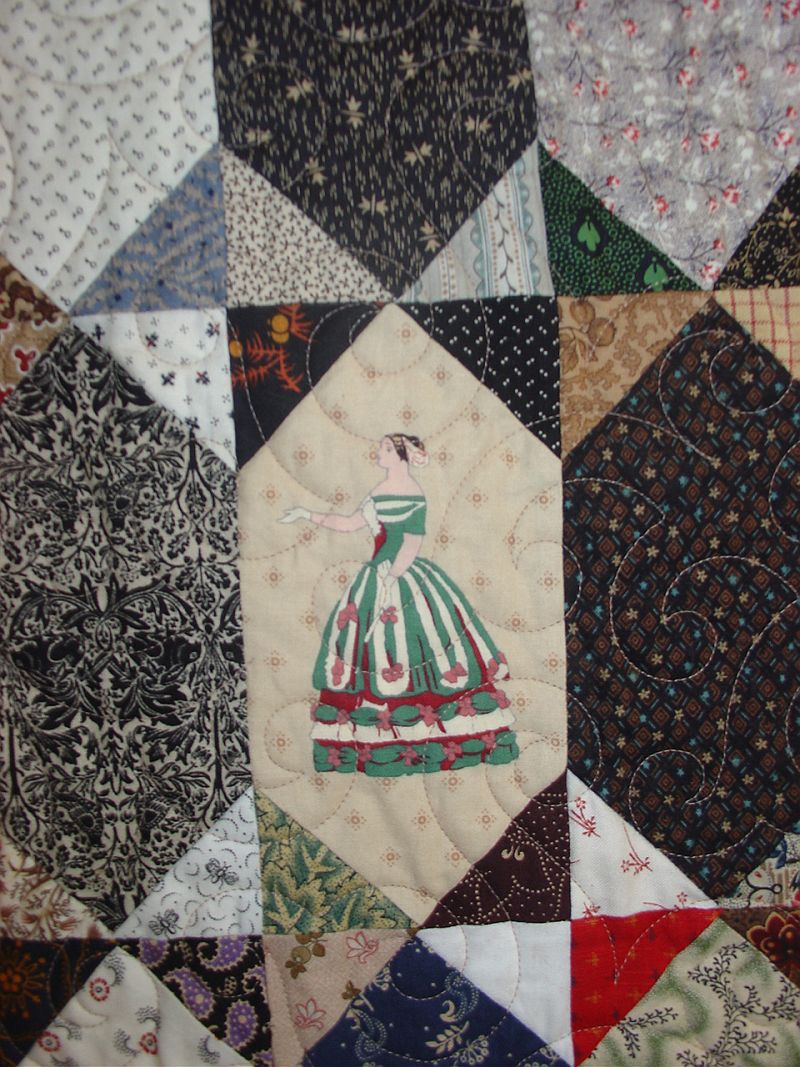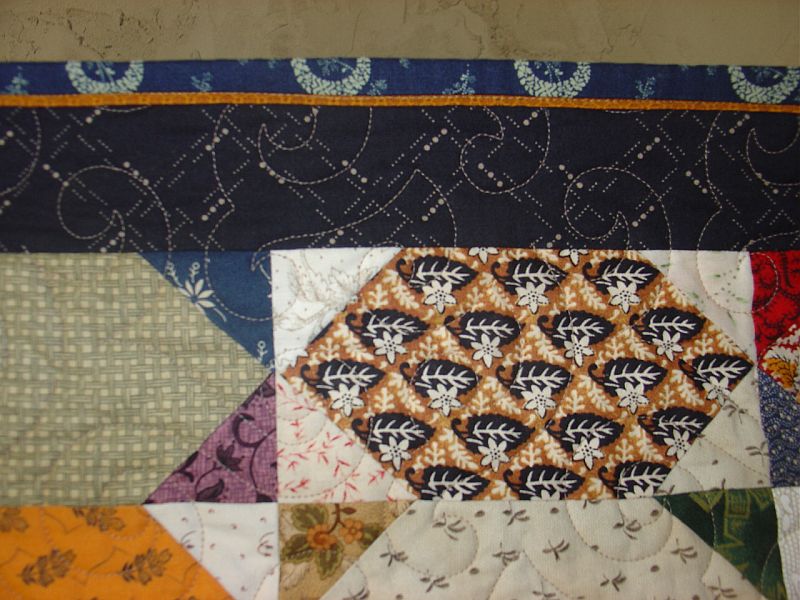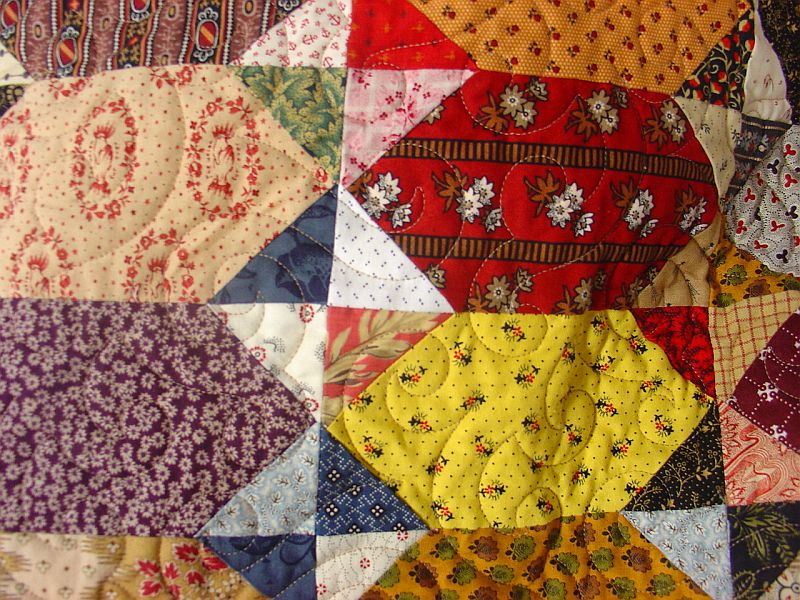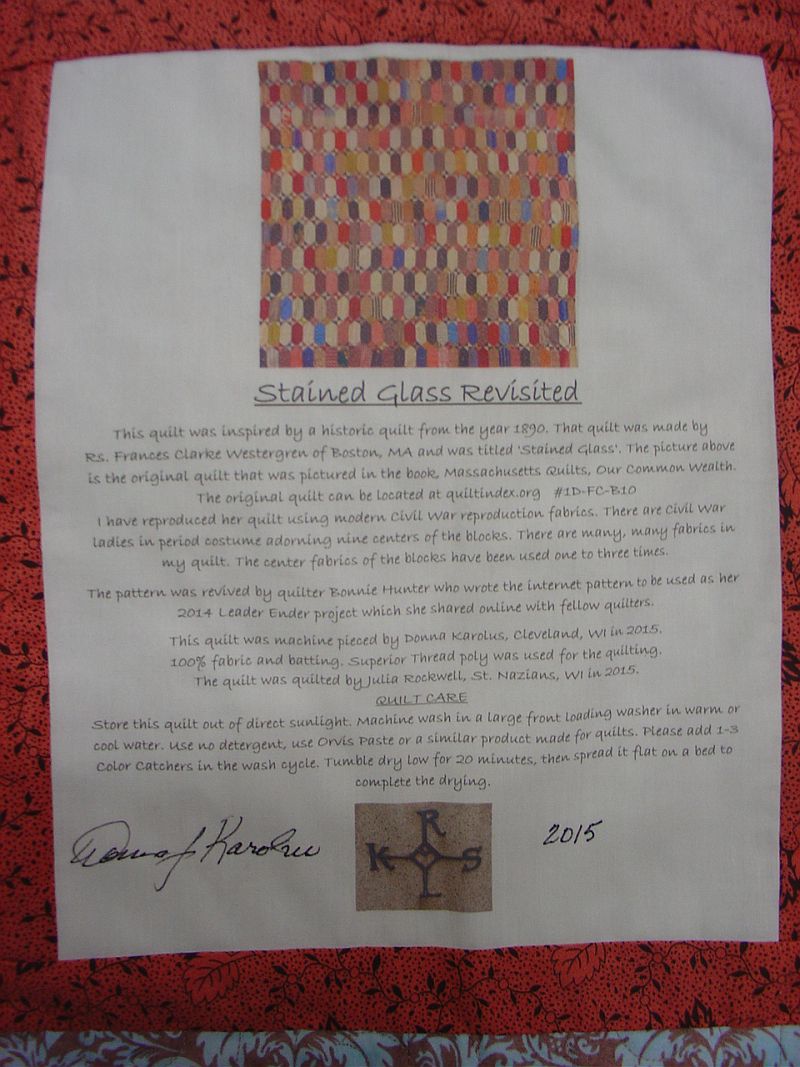BACK TO QUILTS
Stained Glass Revisited; Stained Glass, Fantastic Patchwork, Quintettes
CITE THIS QUILT
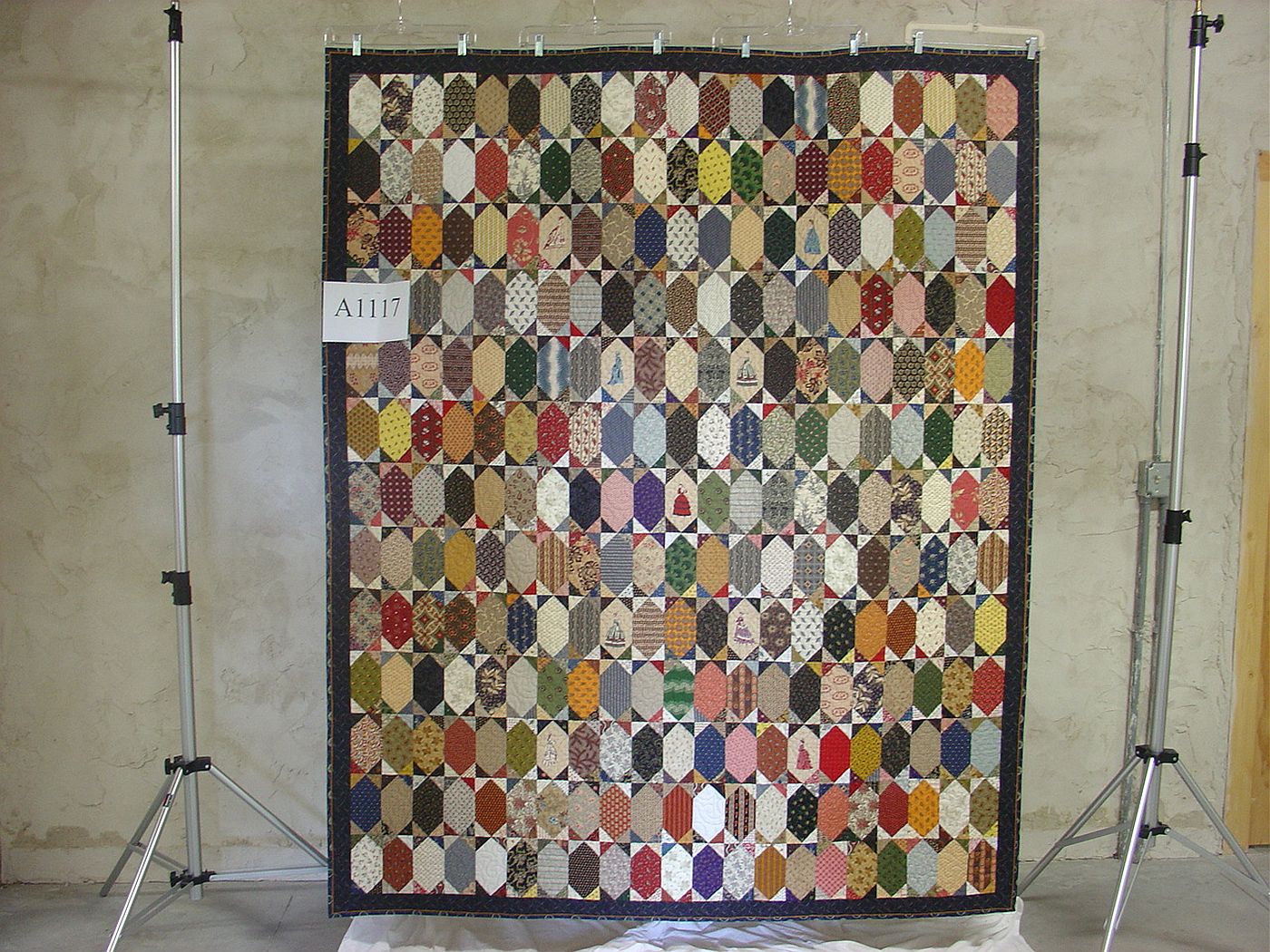
QUILT INDEX RECORD
15-11-1055
Where are the records for this quilt housed?
Wisconsin Quilt History Project
Who documented this quilt?
Wisconsin Quilt History Project
Wisconsin Quilt History Project Number:
A1117
Person filling out this form is:
Quiltmaker; Quilt owner
When was the form filled out?
06-20-2015
Choose the best description of the source to the quilt:
Quiltmaker; Quilt owner
How did the quiltmaker participate in the creation of the quilt?
Bound the quilt; Made entire quilt top
If you are the quilt owner, how did you acquire this quilt?
Made the quilt
Where was the quilt documentation day held?
Wisconsin Museum of Quilts & Fiber Arts
This is a:
Finished quilt
Quilt's title:
Stained Glass Revisited
Names for quilt's pattern in common use:
Stained Glass, Fantastic Patchwork, Quintettes
Brackman # or other source & #:
432a variation
How wide is the quilt?
66.5 in.
How long is the quilt?
81.5 in.
Shape of edge:
Straight
Shape of corners:
Straight
What color is the quilt?
Beige or Tan; Black; Blue or Navy; Brown; Burgundy; Cream; Fuchsia; Gold; Gray; Green; Lavender; Orange; Pink; Purple; Red; Rust; White; Yellow
Overall color scheme:
Multicolor
Quilt's condition:
Excellent/like new
Type of inscription:
Date; Initials; Message; Multiple Names; Place; Signature; Other
Describe the type of inscription:
Logo signature, photograph
What is inscribed on the quilt?
Inscription 1 "Stained Glass Revisited 2015 Pieced by Donna Karolus, Cleveland, WI. The inspiration for this quilt comes from a historical quilt from 1890, by R.S. Frances Clarke Westergren of Boston U.S.A." Inscription 2 "This quilt was inspired by a historic quilt from the year 1890. That quilt was made by R.S. Frances Clarke Westergren of Boston, MA and was called "Stained Glass". The picture above is the original quilt that was pictured in the book, Massachusetts Quilts, Our Common Wealth. The original quilt can be located at quiltindex.org, #1D-FC-B10. I have reproduced her quilt using Civil War reproduction fabrics. There are Civil War ladies in period costume adorning nine centers of the blocks. There are many, many fabrics in my quilt. The center fabrics of the blocks have been used one to three times. The pattern was revived by quilter Bonnie Hunter who wrote the internet pattern to be used as her 2014 Leader Ender project which she shared online with fellow quilters. This quilt was machine pieced by Donna Karolus of Cleveland, WI in 2015. 100% fabric and batting. Superior Thread Poly was used for the quilting. The quilt was quilted by Julia Rockwell, St. Nazianz, WI in 2015. Quilt Care Store this quilt out of direct sunlight. Machine wash in a large front loading washer, in warm or cool water. Use no detergent, use Orvis Paste or a similar soap made for quilts. Please add 1 - 3 color catchers in the wash cycle. Tumble dry low for 20 minutes, then spread quilt flat on a bed to complete the drying. Donna Karolus 2015"
What is the date inscribed on the quilt?
2015
Method used to make the inscription:
Attached label; Computer generated; Ink
Location of inscription:
multiple locations; on back; other
Describe where the inscription was found:
2 separate inscriptions on back
Time period:
2000-2025
When was the quilt finished?
2015
Family/owner's date for quilt:
2015
Describe the quilt's layout:
Block pattern
Number of quilt blocks:
273
Size of quilt blocks:
3 x 6 in.
Arrangement of quilt blocks:
Straight
Spacing of quilt blocks:
Side by side
Number of different block patterns used in the quilt:
1
Number of borders:
1 with flange/piping
Describe the borders:
Single outer dark blue and gold print border with gold tone-on-tone print flange/piping around outer edge.
Fiber types used to make the quilt top:
Cotton
Fabric types used to make the quilt top:
Broadcloth
Fabric styles used in the quilt top:
Floral; Geometric; Multiple scrap; Novelty; Plaid; Print; Striped; Other
Piecing techniques used to make the quilt top:
Machine Piecing
Materials used to make the back:
Cotton
What color is the back of the quilt?
Blue or Navy; Brown
Number of pieces of fabric in the quilt back:
2
Width of pieces on the back:
33 & 33 in.
Describe the back:
Machine sewn; Print; Same fabric used throughout
Materials used in the quilt binding:
Cotton
Fabric structure of the binding:
Plain weave
How is the binding made?
Hand sewn; Home cut; Machine sewn; Separate binding applied; Straight grain
What is the width of the binding (measure on the top only)?
half inch - one inch
What kind of filling is used in the quilt?
Cotton
How are the layers held together?
Machine quilting
Thread type used for the quilting:
Superior Thread Poly
Color of thread used in the quilting:
Beige
Can you see any knots on the front or back of the quilt?
no
Quilting designs used, overall motifs:
All-over-design
Quilting designs used, background fills:
None
Describe the quilting designs used:
An all over long arm Pantograph-Arabesque design by Urban Elementz.
Features or notes about the quilt's appearance, materials, or construction:
Novelty fabric has the images of 9 Civil War ladies in period costumes.
Quilt top made by:
Karolus, Donna J.
Quilted by:
Rockwell, Julia
Where the quilt was made, city:
Cleveland
Where the quilt was made, county:
Manitowoc
Where the quilt was made, state:
Wisconsin (WI)
Where the quilt was made, country:
United States
How was this quilt acquired?
Other
Describe anything about the history of the quilt that wasn't already recorded in a previous field:
Donna Karolus machine pieced the quilt top and bound the quilt. Julia Rockwell from St. Nazianz/Manitowoc County, Wisconsin quilted the quilt.
Why was the quilt made?
Art or personal expression; Therapy
The quilt was made to be used for:
Bedding, special occasion
Where did the maker get their materials?
Purchased new; Sewing scraps
Where did the maker find their pattern?
Another quilt; Traditional pattern variation
Where did the quiltmaker find the pattern for the quilting design on the quilt?
Commercial pattern
Describe where the quilting design pattern was found:
Long Arm Pantograph-Arabesque design by Urban Elementz
Describe anything about the design of the quilt that wasn't already recorded in a previous field:
Reproduction prints from the 19th century, Civil War era were used. The design for the quilt was derived from a quilt from the 1890's by Dr. Frances Clarke Westergren from Boston/Suffolk County, Massachusetts. A photograph of this quilt is on page 62 of the book Massachusetts Quilts, Our Common Wealth, edited by Lynne Zacek Bassett. University Press of New England, 2009.
Ownership of this quilt is:
Private
Quiltmaker's gender:
Female
Quiltmaker's educational background:
College
In which kind of environment did the quiltmaker live?
Rural
How did the quiltmaker learn to quilt?
From Friend; Self-Taught
When did the quiltmaker learn to quilt?
Age 40-49
Why does the quiltmaker quilt?
Gifts; Necessity; Pleasure; Therapy
Estimated number of quilts made by this quiltmaker:
20-50 quilts
Does/did the quiltmaker sell quilts?
no
Does/did the quiltmaker teach quilting?
only informally
Any other notes or stories about the quiltmaker:
Donna Karolus was present for this documentation. Personal information is in reference to her. Other quilts by Donna Karolus and Julia Rockwell have been documented in the Quilt Index at A1116 & A1118. Ms. Karolus preferred not to give detailed personal information about her family and herself.
Access and copyright information:
Restricted
Copyright holder:
Wisconsin Museum of Quilts & Fiber Arts
Details
Cite this Quilt
Karolus, Donna J. Stained Glass Revisited. 2015. From Wisconsin Quilt History Project, Wisconsin Quilt History Project. Published in The Quilt Index, https://quiltindex.org/view/?type=fullrec&kid=15-11-1055. Accessed: 04/25/24
